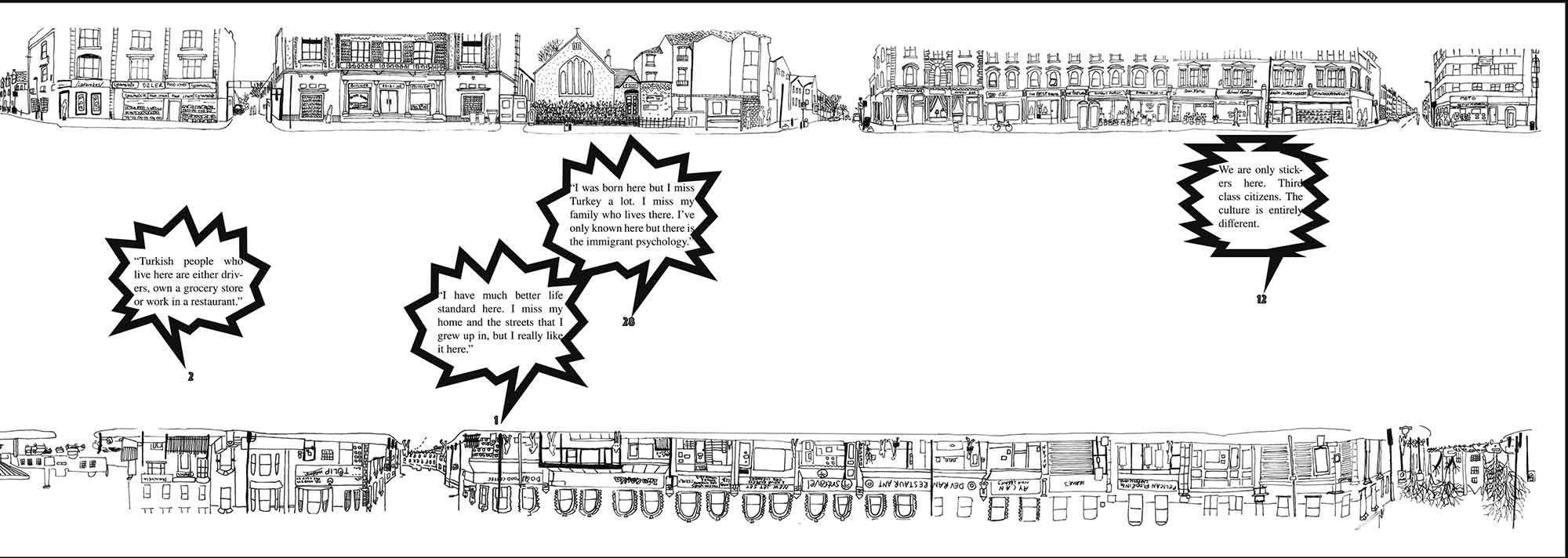


“We are only stickers here. Third class citizens.”
Even though interviewees perceive themselves as ‘the other’ and resist change, they have to adapt to the ‘rules of the culture’ they live in, through tactics; yet interviewees also mentioned to me that some things in Dalston were done ‘the Turkish way’, suggesting a short circuit found in the system.
“We are only stickers here. Third class citizens.”
This project takes Kingsland High Street as its area of interest and uses eleven interviews conducted on site with Turkish migrant shop owners and workers (all of whom are men) as its primary reference. The interviewees’ expressions were indicative of a pattern, either by mentioning the same issues or referencing certain notions of home, country or social life.
Kingsland High Street is growing with popularity as a social attraction in London, going through gentrification and accommodating different communities, thus providing a versatile environment for architectural, social and ethnographic research. (1) For this reason, in aiming to incorporate the subjectivity of the position of a Turkish migrant, rather than attempting to systematize the research process from an objective basis, the project took the expressive form of a collage-drawing ‘map’ of relations. Subjectivity was the key starting point for this research. The project aims to investigate and discover the unregistered political and cultural memories of these migrants through their individual recollections and the aesthetics of the shops on the street by drifting through the site, talking to people, taking photos of details and combining these into a narrative as a collage.
The project attempts to communicate the micro cosmos of the spaces where the interviews took place as well as the social and political positions of the participants through images as visual materials. The collage as a physical object is a constructed historical landscape, that, in a way, is a spatialization of a memory. (2)
1. muf and J&L Gibbons LLP, Making Space in Dalston, (London: London Borough of Hackney, 2009).
2. Mieke Bal, Looking In: The Art of Viewing(Amsterdam: G+B Arts International, 2001).
I received my BArch from Istanbul Bilgi University in 2014 and completed my MA in Architectural History at the Bartlett in 2016. I took the Theorising Practices/Practising Theories: Art, Architecture, Urbanism course during this time, in Spring 2015-2016. I am currently doing a PhD in Architectural Design at Istanbul Technical University and working as a research assistant in Maltepe University, Istanbul. My PhD studies are oriented around architecture, tourism and travelling. Parallel to this, my interests include architecture and leisure culture, urban geography and cultural history. My most recent article on the culture-oriented gentrification of Brick Lane was published in the February issue of the Turkish journal Mimarlık. Currently I am interested in producing a political food map of Northern Cyprus.
I tried to tackle one of the concepts that we frequently discussed during our site-writing classes: subjectivity. I realized through this project, that the concept of subjectivity manifested itself in the physical qualities of the spaces, cultural gestures and language (of the interviewees) as well as in my position as the researcher and finally the gaze of the viewer. This work explored the articulation of a site that ‘revealed’ itself through site visits. During and after these visits, I had to bodily engage with and develop a response towards the site, which was essentially how I understood site-writing.
MUF, Making Space in Dalston maps (2009), London, https://issuu.com/mufarchitectureartllp/docs/making_space_big
Gort Scott Architects, High Street London drawings (2009-2010), London, http://www.gortscott.com/project/high-street-london/
Ed Ruscha, Every Building on the Sunset Strip (1966), LA.






































































